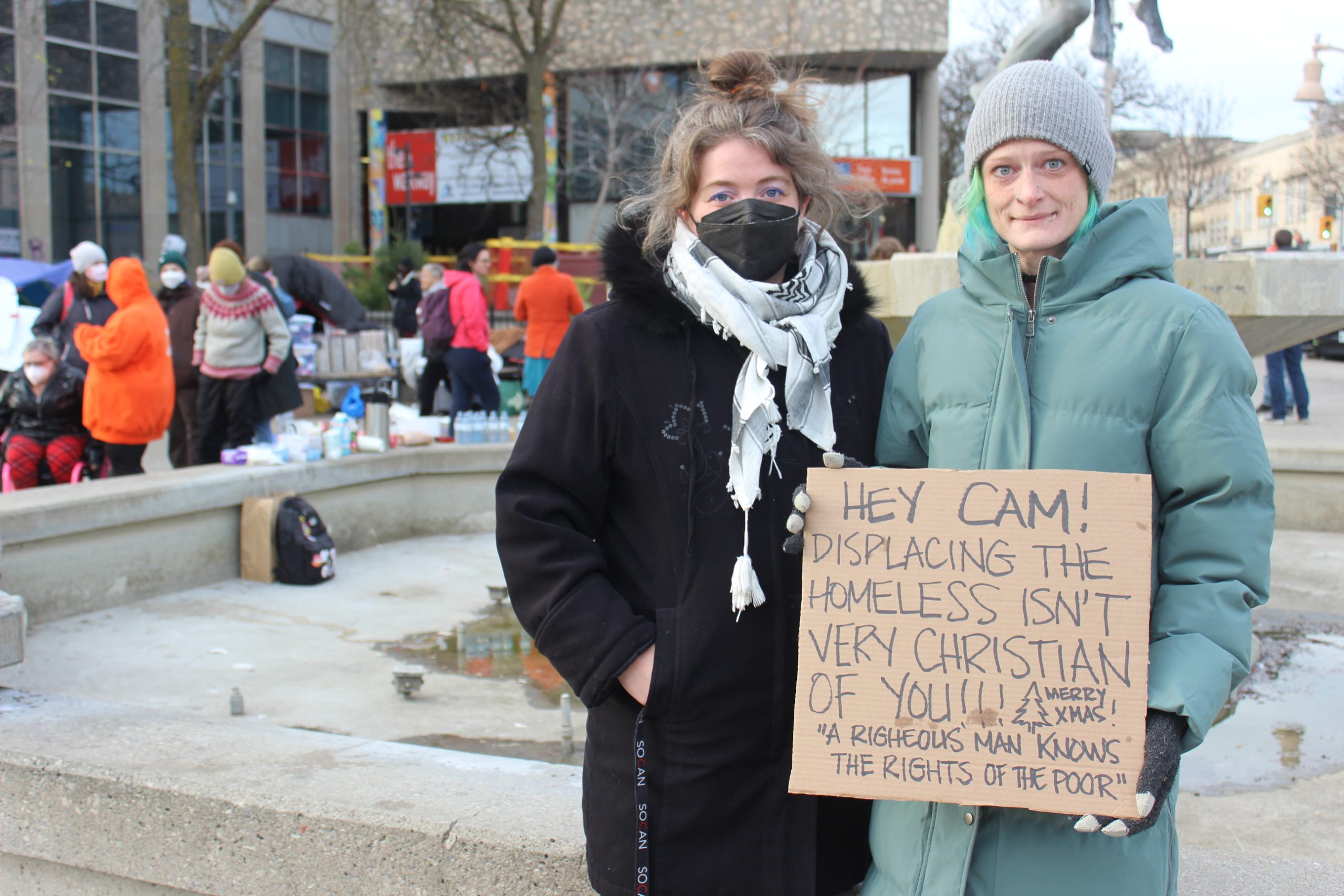GUELPH – People living in St. George’s Square were given written notice late last month to remove their tents by 4pm on Nov. 13.
But City of Guelph staff did not wait until the afternoon deadline to start dismantling and removing tents from a raised garden bed in the square.
People scrambled to pack up and find safe places to store their things while city staff dragged tents away and unloaded dozens of evergreen shrubs to plant in the space.
A cold wind rushed through downtown as Jeff Dillon watched over his belongings while people planted shrubs in the spot where his tent had been hours before.
He politely pleaded with the workers to stop getting soil on his stuff, and assured Guelph Police officers that his possessions had not been abandoned, as the officers repeatedly suggested they had.
‘Respectful, human-centred’
Asked for comment, City of Guelph deputy CAO of public services Colleen Clack-Bush offered an emailed statement.
“The city has committed to leading with a respectful, human-centred and education-first approach,” she stated.
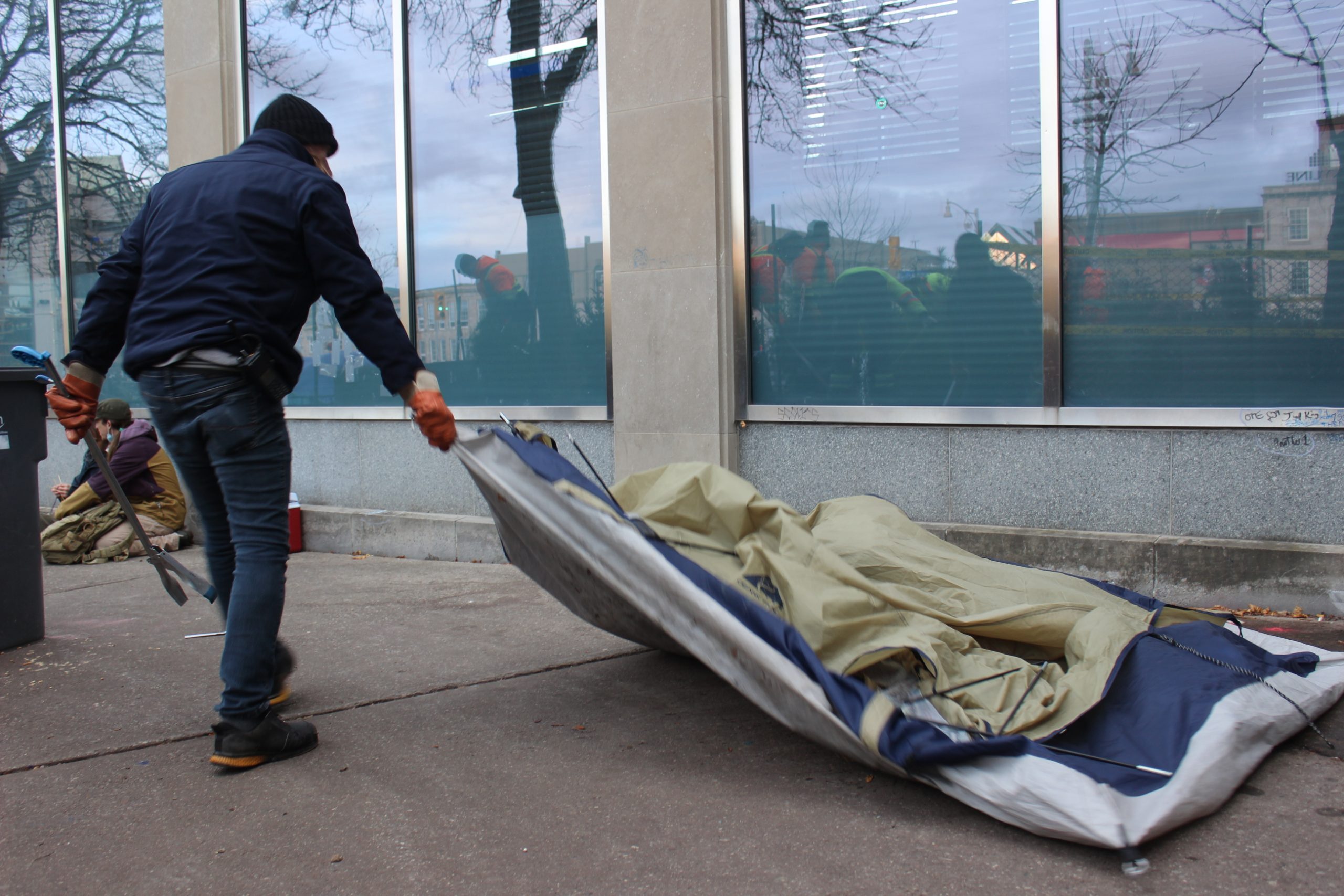
City of Guelph staff dragged homeless people’s tents out of St. George’s Square on Nov. 13 and loaded them into city pickup trucks.
“Following verbal notice (along with support agency information and an infographic) … a written notice was provided indicating that structures were to be cleared out today,” she continued.
When the written notices were provided, there were about 20 tents in the square.
By 4pm on Nov. 13, two tents remained standing.
Clack-Bush said staff would remove any remaining shelters “in the coming days.”
In a follow-up email on Nov. 14, Clack-Bush stated “all individuals chose to voluntarily relocate out of the Square” prior to the Nov. 13 deadline, with city staff helping people pack up “once they have been vacated and we have confirmation that the individual has relocated elsewhere.”
However, that was not the scene witnessed by Advertiser staff on Wednesday afternoon.
Several homeless people could be heard begging to stay a little longer, at least until they found somewhere to put their things.
Clack-Bush stated city staff was “planting approximately 100 evergreen shrubs, due to the time of year and our desire to have the planted materials survive through the winter.”
She said she doesn’t “have the specifics on the cost” of the plants.
‘Stigma and abuse’
Dillon said he took down his own tent because he has “put up with enough stigma and abuse” in the encampment.
This includes university students and others physically assaulting homeless people, urinating on tents and yelling from cars, in addition to “constant harassment from police,” he alleges.
There was a significant police presence on Thursday, but Guelph Police spokesperson Scott Tracey said, “As far as I’m aware we had no involvement in what occurred at the square today … Our only involvement would have been to stand by and ensure everyone’s safety, however I don’t believe we were asked to assist.”
Police officers interacting with people in the square declined Advertiser requests for comment.
“Extra policing and harassment from police is not an answer here,” Dillon said.
“If things don’t work, the answer is not to continue the same method, or do less. There has to be something more done.”
But Dillon expects that “a lot more people are going to die before something is done.”
On Nov. 8, two people died of suspected drug poisoning in the encampment.
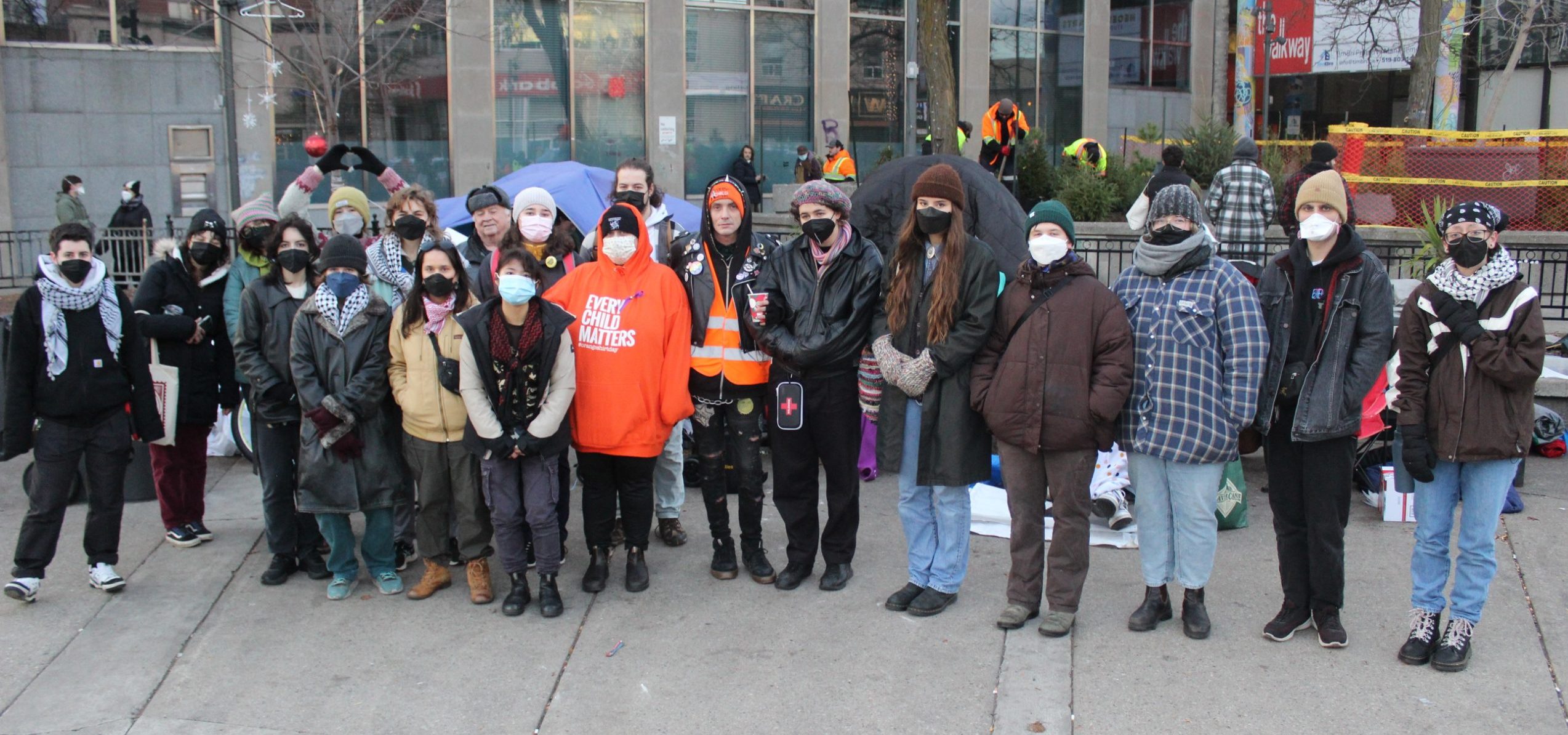
Some of the people who gathered in St. George’s Square on Nov. 13 to show support for the homeless community living there. In the background, City of Guelph staff plant shrubs where tents previously stood.
‘No one wants to be homeless’
“No one wants to be homeless,” Dillon said. “None of us want to be here.”
But people pick downtown as the place to set up their tents for a variety of reasons, including its visibility, which he said seems like the only way to show people what a serious problem homelessness is.
“A lot of us need help. We don’t have family, or any way of getting help, ” Stephan Robinson told the Advertiser.
He described people directing a wide range of violence towards him because he is homeless, including, “Taking a bat to me and my girlfriend … jumping us” and destroying their tent.
Community support
People lingered in the square throughout the day in an attempt to offer support to those living there and to bear witness to the day’s events.
By 5pm, about 50 people were standing in the square, including homeless people, social workers, police, bylaw officers, City of Guelph staff and community members.
These community members included Kate Nixon, Mars Russell, Tay Anton, Zoey Bakker and Celidh Barker.
Nixon said she witnessed a lot of fear and uncertainty from homeless people throughout the day, with many unsure where they will go next.
“A lot of people are scared that when they move, they will just be asked to move again in a couple of days,” Russell added.
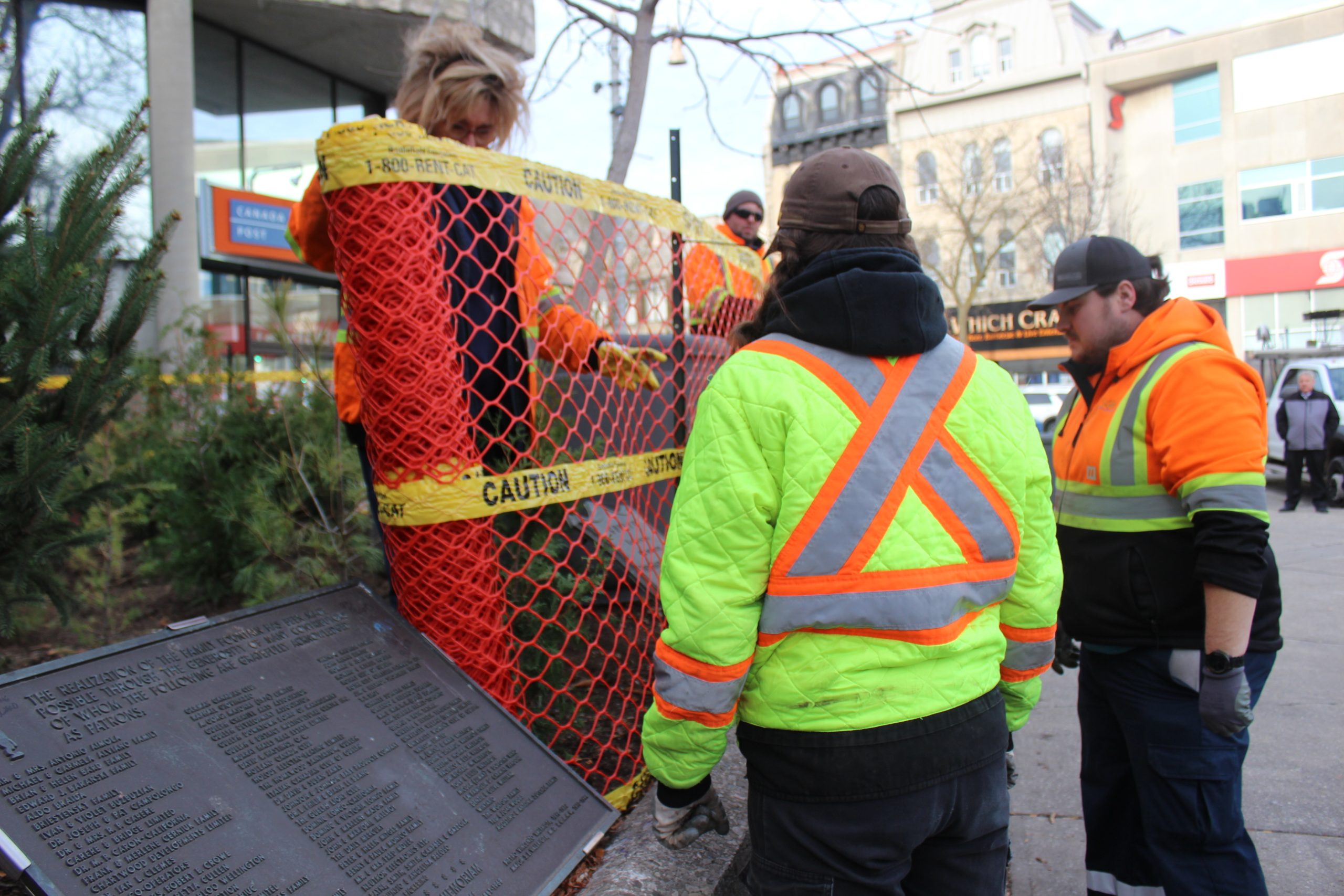
City of Guelph staff erected a fence around a raised bed in St. George’s Square after planting it densely with a mix of evergreen shrubs.
Public space use bylaw
“It’s especially difficult as the map is not up on the website,” Nixon said, referring to a map that illustrated where encampments are allowed based on a new public space use bylaw.
The map was briefly available on the City of Guelph website and then taken down.
The bylaw, which went into effect on Oct. 1, regulates where and when temporary structures such as tents are permitted on city property.
“I think every councillor who voted for this bylaw should be here,” Russell said, “to help people move and to bear witness to the impact of the bylaw that they voted on.”
Many community members in favour of the public space bylaw have described feeling unsafe and losing business due to the downtown encampment.
Bakker is a single mom who lives near downtown and whose child attends school a few blocks from the square.
“Not once have we felt unsafe around the people who live at the encampment,” Bakker said.
“I still take my child downtown frequently and my experience is that if you smile at our unhoused community members, they smile back, and that’s it.”
Barker has lived and worked downtown for over a decade, and called the people living in the encampment their neighbours.
“I’ve never felt that my safety or livelihood is at risk by making space for people to survive close to the few resources available to them,” said Barker.
‘They’re not at fault’
“People are being displaced because of a situation they landed in – they’re not at fault,” Anton said.
They said though officials say people in the encampment were offered places to stay, not everyone has somewhere to go.
“People are getting turned away for various reasons.”
“There are more people on the by-name list than there are shelter beds,” Nixon said, referring to a real-time list of homeless people that Guelph and Wellington County officials know by name.
“Housing people is not as difficult as city officials claim it to be,” Bakker said.
“In my neighbourhood alone almost a dozen homes stand empty and the city doesn’t have a vacancy tax or restrictions on Airbnbs.”
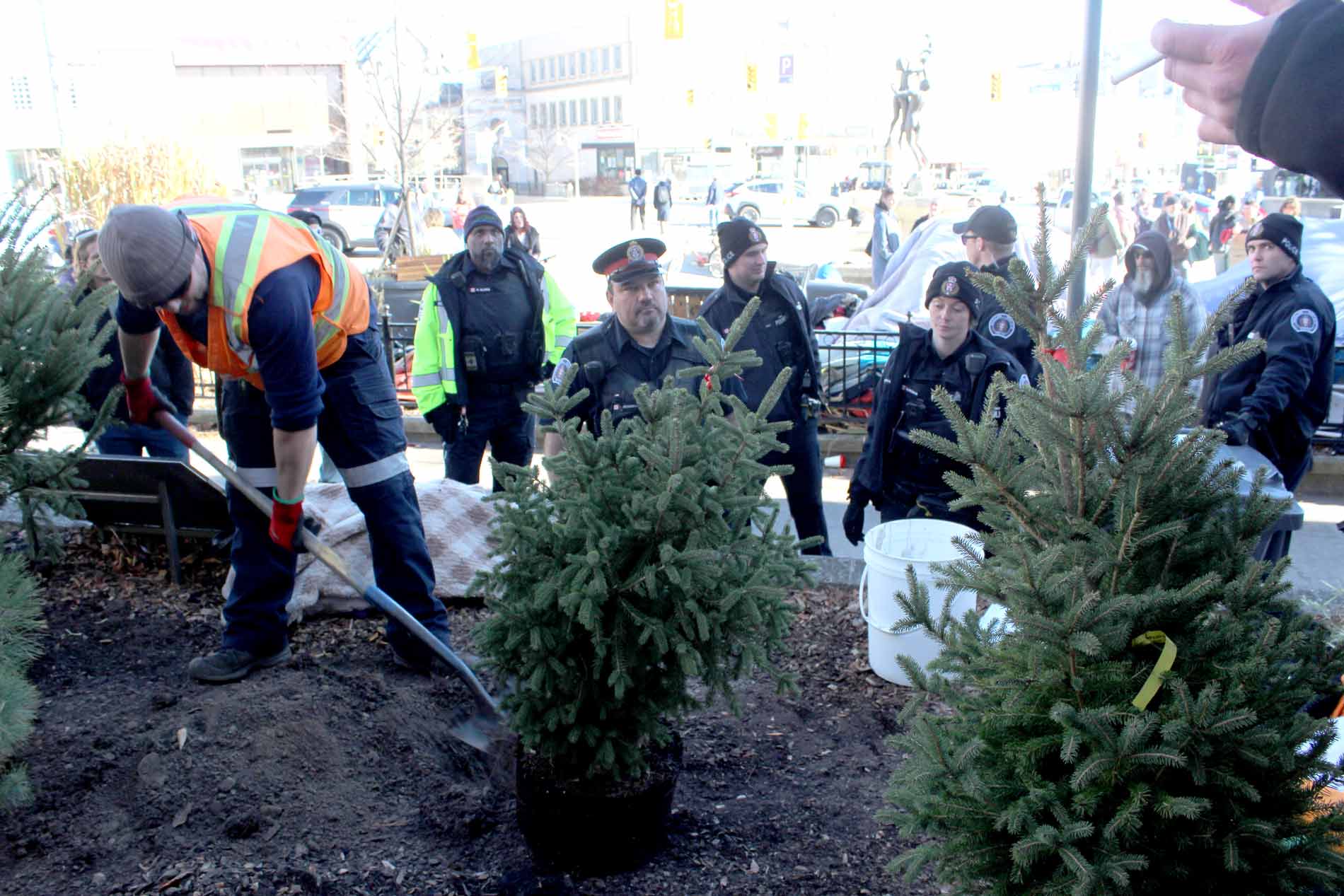
Guelph Police officers watch closely while city staff members plant evergreen shrubs in the place where tents were previously sheltering homeless people.
‘We will continue to lose people’
Russell said it felt “truly humbling” to help homeless people pack away their things while “city workers paid to be here” stood by and watched, without offering help.
“It’s very sad to see people have to lose what little they already have,” Nixon said.
“And after losing two people,” Russell added, referring to the Nov. 8 deaths.
Nixon expressed deep grief for the lives lost. “How sad is it that we lost two people? And their deaths were preventable.
“We can take action that would save lives. Instead, we are displacing people,” she said.
“I wish we were coming together as a community to stop more lives from being taken.
“We are literally failing people. We will continue to lose people if we don’t take compassionate action.”
Plantings
Bakker said she came downtown on Nov. 13 to “show the hypocrisy of … replacing the homeless with symbols of Christmas, a time when people believe their saviour was born unhoused.”
Russell said it is ironic city officials planted cedars, the source of sacred medicine for many Indigenous people, while displacing homeless Indigenous people who were living in the square.
For Anton, the one positive aspect of Wednesday’s events was the connections people built with one another.
“Hope and power lies in the community coming out to support each other,” they said.
Russell said they hope those who came out to show support understand “This isn’t an end,” and continue to show up, even if there are no tents left standing in the square.




